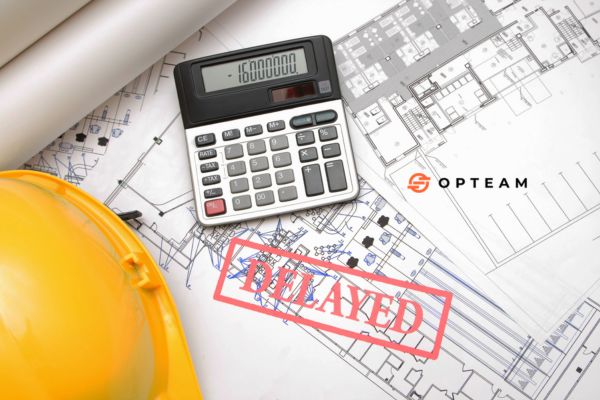Compensable Delays in Construction: Full Guide

In the last 10 seconds, a construction project somewhere just lost thousands due to compensable delays. Contractors are stuck dealing with slow approvals, vague contract terms, and owners who shift blame to avoid paying up. Meanwhile, outdated scheduling tools and manual documentation make it nearly impossible to track delays in real time—until it’s too late. The result? Cash flow issues, legal disputes, and projects running months behind. If you’re tired of fighting to get paid for delays that aren’t your fault, it’s time to fix the process. Let’s break down compensable delays, how to identify them, and how to ensure you’re properly compensated. What are Compensable Delays in Construction? Every day, construction projects fall behind schedule—but not all delays are the contractor’s fault. Some are caused by the project owner, engineers, or unforeseen conditions, and when that happens, contractors may be entitled to extra time or compensation. These are called compensable delays—delays for which the contractor has a legal right to claim damages, usually due to the owner’s actions or failures. Compensable delays often include late design approvals, scope changes, site access restrictions, or delays in providing necessary information. Unlike excusable delays, which may grant a time extension but no financial compensation, compensable delays impact both schedule and cost. The key is proving the delay, documenting its impact, and ensuring the contract terms support your claim. Causes of Compensable Delays Not every delay is the contractor’s fault. When the owner, consultant, or another party disrupts the schedule, it can lead to compensable delays—delays that entitle the contractor to both time extensions and financial reimbursement. Here are the most common causes: 1. Late Approvals and Decision-Making Many projects stall because owners or consultants take too long to approve designs, materials, or change orders. When these delays prevent work from progressing as planned, they become compensable. 2. Scope Changes and Design Revisions Mid-project modifications—whether adding new work, changing specifications, or redesigning elements—can significantly impact the schedule. If these changes come from the owner or their team, they are compensable. 3. Restricted Site Access If a contractor is unable to access the site as planned due to the owner’s failure to clear land, relocate utilities, or provide necessary permits, the resulting delays can be grounds for compensation. 4. Failure to Provide Information or Materials Construction depends on timely information and materials. If an owner delays the release of construction drawings, specifications, or required resources, work slows down, and the contractor may claim compensation for lost time and increased costs. 5. Interference from the Owner or Third Parties Direct interference, such as excessive inspections, additional testing requirements, or on-site restrictions imposed by the owner, can slow progress. Similarly, third-party disruptions (like delays caused by separate contractors hired by the owner) may also qualify as compensable. 6. Delayed Payments When owners fail to make timely payments, contractors may struggle with cash flow, leading to work stoppages. If the delay in payment directly affects project progress, the contractor can claim compensation for damages incurred. Understanding these causes is the first step to protecting your rights. But knowing how to document and claim compensable delays effectively is what ensures you actually get paid. How to Prevent Compensable Delays While compensable delays can lead to time extensions and financial claims, preventing them in the first place is the best way to keep projects on track. Here’s how contractors and project owners can minimize the risk of compensable delays: 1. Clear Contract Terms A well-defined contract is the foundation for avoiding disputes. It should clearly outline responsibilities, deadlines, approval processes, and compensation clauses to prevent misunderstandings. 2. Efficient Approval Processes Delays in approvals—whether for designs, materials, or change orders—are a common cause of compensable delays. Establishing strict approval timelines and ensuring all stakeholders adhere to them can keep the project moving forward. 3. Regular Communication Frequent coordination meetings between contractors, owners, and consultants help identify and resolve issues early. Open communication ensures that any potential delays are addressed before they become costly problems. 4. Proactive Schedule Monitoring Using real-time scheduling tools helps track progress and detect potential delays before they escalate. By continuously reviewing the project schedule, teams can take corrective action when needed. 5. Proper Documentation Detailed records of approvals, change orders, and communications are crucial for avoiding disputes. If a delay does occur, proper documentation can help contractors justify claims for compensation. 6. Timely Payments Delayed payments can cause cash flow issues, slowing down work and leading to compensable delays. Owners should ensure payments to contractors and subcontractors are made on time to avoid disruptions. 7. Effective Change Management Scope changes are sometimes unavoidable, but they should be handled in an organized manner. A structured process for evaluating and approving changes helps minimize unexpected delays and cost overruns. Use Opteam to Reduce Delays by 30% Most construction delays aren’t just frustrating—they’re expensive. Waiting weeks for approvals, tracking schedules manually, and scrambling to document delays can cost your project time and money. With Opteam, you get real-time progress tracking, automated reporting, and a streamlined approval process—all designed to cut delays by 30% and keep your projects on track. Instead of relying on outdated software or messy spreadsheets, Opteam gives you instant visibility into your project timeline. You’ll know exactly where delays are happening, who’s responsible, and how to act fast to prevent them from escalating. The result? Faster approvals, fewer disputes, and projects that finish on time and within budget. Start your free trial now and take control of your construction schedules!
Critical Delay in Construction: The Hidden Threat

Critical delays in construction projects are more common than you might think. They often lead to extended timelines and budget overruns, creating significant challenges for project teams. In fact, a study revealed that large construction projects take 20% longer to finish than planned and can exceed budgets by up to 80%. These delays can arise from poor planning, budget constraints, communication gaps, or unexpected external factors. When left unaddressed, they not only disrupt progress but also strain relationships between stakeholders and impact project profitability. The good news? With the right project management strategies, better communication, and advanced scheduling tools, you can keep your projects on track. Let’s dive in What is a Critical Delay in Construction? A critical delay in construction occurs when a project milestone or task is delayed to the point where it affects the overall project completion date. These delays typically impact critical path activities—tasks that directly influence the project’s timeline. When a critical delay happens, it can lead to extended deadlines, financial penalties, and strained relationships with clients or stakeholders. What makes critical delays especially challenging is that they often stem from a mix of factors, such as design errors, labor shortages, material delivery issues, or even unforeseen site conditions. Since critical path tasks have zero flexibility in scheduling, any delay in them requires immediate attention to avoid cascading effects on the entire project timeline. Examples on Critical Delays How to Deal with Critical Delays? Dealing with critical delays in construction requires a proactive and strategic approach. The first step is identifying the root cause of the delay through a thorough project review. Once the cause is clear, prioritize open communication among all stakeholders, including contractors, suppliers, and clients. Regular progress meetings and status updates can help ensure everyone stays informed and aligned on the next steps. Additionally, updating the project schedule with revised timelines and task dependencies is crucial for maintaining control over the project flow. Another effective strategy is resource reallocation and fast-tracking. If one phase is delayed, consider shifting resources to accelerate other non-affected tasks or work in parallel when possible. Implementing modern progress tracking tools with Gantt charts like Opteam or critical path method (CPM) software can also help visualize and manage dependencies more effectively. Ultimately, proactive risk management, combined with transparent communication and flexible scheduling adjustments, can significantly reduce the impact of critical delays on construction projects. Minimize Critical Delays with Opteam’s Smart Construction Management Tools Critical delays can derail construction projects, leading to missed deadlines, budget overruns, and strained stakeholder relationships. Opteam provides a smarter way to manage construction timelines by giving you real-time visibility into project progress, so you can identify and address delays before they escalate. With automated progress tracking and dynamic scheduling, staying on top of critical tasks has never been easier. When a delay occurs, fast decision-making is essential. Opteam’s intuitive dashboards allow you to instantly assess project health, track critical path activities, and reassign resources where they’re needed most. With detailed insights and collaborative tools, teams can maintain clear communication and adjust timelines in real-time, keeping everyone aligned and minimizing disruption. Opteam isn’t just about tracking delays — it helps you prevent them. Start your free trial now & test it yourself.
Extension of Time in Construction: Procedure & Best Practices

In short: An Extension of Time (EOT) is a contractual mechanism in construction projects that allows for the adjustment of the agreed-upon project completion date due to delays caused by unforeseen events or circumstances beyond the contractor’s control. These delays may stem from adverse weather, unexpected site conditions, client-initiated changes, or force majeure events such as natural disasters. The EOT provision is typically included in construction contracts to ensure that contractors are not unfairly penalized for delays that are not their fault, preserving the integrity of the contractual timeline. The primary purpose of an EOT is to maintain fairness and clarity between all parties involved in the construction process. By formally recognizing delays and revising the project timeline, EOT provisions prevent disputes over liquidated damages and ensure that contractors have adequate time to complete the work to the required standard. This adjustment not only safeguards contractors but also protects the client’s interests by ensuring the project remains aligned with contractual obligations. Ultimately, EOT provisions promote collaborative problem-solving and clear communication, reducing the likelihood of conflicts during project execution. Importance of EOT in Construction Contracts Extensions of Time (EOT) play a crucial role in construction contracts by providing a structured framework to address delays, ensuring that all parties are treated equitably. Construction projects often face unforeseen circumstances such as adverse weather, design changes, or delays in approvals, which can impact the timeline. Without EOT provisions, contractors risk unfair penalties for events outside their control, such as liquidated damages for delays. By granting an extension for valid reasons, EOT clauses safeguard contractors while maintaining the contractual integrity of the project. Common Causes for EOT Claims Unforeseen Site Conditions Unexpected issues, such as hidden underground utilities or unstable soil, can disrupt construction activities and require additional time to address. Adverse Weather Conditions Severe weather, like heavy rain, storms, or extreme temperatures, can halt work on-site and delay project progress. Client-Initiated Changes Modifications or additions to the project scope by the client can necessitate extra time to incorporate the changes effectively. Force Majeure Events Unpredictable events, including natural disasters or political unrest, can significantly impact the project schedule, warranting an extension. Delays in Approvals and Permits Delays in obtaining necessary permits or approvals from authorities can hinder the start or continuation of work, requiring a timeline adjustment. Are You Actually Eligible for an Extension of Time? Before submitting an EOT request, use this quick decision flowchart to verify your eligibility. Contractual Provisions Related to EOT Standard Clauses in Construction Contracts Most construction contracts include specific clauses that govern Extensions of Time (EOT), outlining the conditions under which a contractor can apply for an extension. These clauses typically detail valid causes for delays, notification requirements, and the process for assessing and approving claims. Standardized provisions ensure clarity and fairness, reducing disputes and protecting the interests of all parties involved. Time is of the Essence vs. Reasonable Time “Time is of the essence” is a contractual term emphasizing that the project’s completion date is critical, and failure to meet deadlines can lead to penalties or legal consequences. In contrast, “reasonable time” provisions offer more flexibility, allowing adjustments for unforeseen delays. Understanding which approach governs a contract is essential for managing expectations and handling delays effectively. Time at Large: Concept and Implications Time at large occurs when the contractual completion date becomes unenforceable, often due to the client’s failure to grant a justified EOT or provide timely approvals. In such cases, the contractor is no longer bound by a fixed deadline but must complete the work within a “reasonable time.” This scenario can weaken the client’s ability to impose liquidated damages and emphasizes the importance of adhering to proper EOT procedures. Procedure for Filing an EOT Claim Impact of EOT on Project Costs and Scheduling Prolongation Costs An approved Extension of Time (EOT) often results in additional expenses, such as extended site overheads, equipment rental, and labor costs. These costs can burden the contractor unless the delay is compensable, allowing for cost recovery from the client. Adjustments to Project Timeline EOT modifies the contractual completion date, ensuring the contractor is not penalized for valid delays. This adjustment helps maintain realistic project timelines and reduces the risk of disputes over deadlines. Implications for Liquidated Damages When an EOT is granted, the contractor is protected from penalties related to delayed project completion, such as liquidated damages. This provision ensures fairness by recognizing delays beyond the contractor’s control. Cash Flow and Financial Management Delays can disrupt cash flow and project financing, especially if progress payments are tied to milestones. An EOT provides a structured way to address these issues and realign financial expectations. Impact on Critical Path Activities EOT often requires revising the project schedule, particularly the critical path activities. Properly analyzing these impacts ensures that the adjusted timeline remains achievable and realistic. Best Practices for Managing EOT Claims Case Studies and Real-World Examples 1. City Inn Ltd v Shepherd Construction Ltd (2007) In this Scottish case, City Inn Ltd engaged Shepherd Construction Ltd to build a hotel. Delays occurred due to both employer and contractor-related issues. The court adopted an “apportionment” approach, dividing responsibility for delays between the parties. This case highlighted the complexities of concurrent delays and the importance of clear contract terms regarding EOT. 2. Peak Construction (Liverpool) Ltd v McKinney Foundations Ltd (1970) Here, Peak Construction faced delays caused by the employer’s actions, but the contract lacked a clear EOT mechanism. The court ruled that, in the absence of such a mechanism, the completion date became unenforceable, setting “time at large.” This meant the contractor was obligated to complete the work within a reasonable time, emphasizing the necessity of including explicit EOT provisions in contracts. Read more Final Words: Extension of Time in Construction The Extension of Time in Construction is a vital contractual tool to address delays fairly and maintain project integrity. From understanding common causes like unforeseen site conditions and adverse weather to navigating proper claim procedures and the implications on costs and
Delay Damages in Construction Contract: Key Information

In short: In construction projects, delays are inevitable. But what happens when they push project timelines beyond the agreed completion date? This is where delay damages come into play. Contracts often include clauses that penalize contractors for not completing the work on time, which can result in significant financial consequences. Without proper understanding, these clauses can catch contractors off guard, leading to disputes and hefty fines. Imagine working tirelessly on a project, only to be hit with unforeseen costs because of minor delays. Contractors often overlook the fine print in delay damages clauses, assuming they won’t be affected. But even small delays, caused by external factors like weather or supply chain disruptions, can result in penalties. The key to avoiding these pitfalls is understanding how delay damages work in your construction contracts. By familiarizing yourself with the types of damages—like liquidated, actual, and consequential—you can prepare for potential delays and protect your business. Tools like Opteam can help you stay on top of project schedules, preventing delays from spiraling out of control. And when you understand the legal implications, you’re better positioned to negotiate fair terms and avoid costly penalties. What Are Delay Damages? Delay damages refer to the financial penalties imposed on a contractor or party responsible for causing a delay in the completion of a construction project. These damages are typically pre-agreed upon in the contract and are intended to compensate the client or project owner for losses suffered due to the delay. The most common form of delay damages is liquidated damages, which outline a fixed amount to be paid for each day or period the project exceeds the agreed deadline. This is designed to encourage timely project completion and provide a clear financial remedy if delays occur. Common Reasons for Delays in Construction Projects Importance of Delay Damages Clauses Importance of Delay Damages Clauses Delay damages clauses are essential in construction contracts because they serve as a safeguard for project owners. These provisions are included to clearly outline the financial consequences if a contractor fails to meet the agreed-upon completion date. By having a pre-determined penalty, such as liquidated damages, both parties can avoid lengthy disputes and potential litigation over the financial impact of delays. The clause provides a clear framework for accountability, motivating contractors to adhere to timelines and avoid unnecessary delays. The impact of delay damages on project timelines and stakeholders is significant. For project owners, delays can lead to financial losses, such as increased costs, missed revenue opportunities, or disruptions in their operations. Stakeholders like investors, suppliers, and subcontractors also face the ripple effects of delayed projects, which can affect cash flow and lead to strained relationships. By enforcing delay damages, contracts help protect all parties involved, ensuring that timelines are respected and that projects are delivered without costly setbacks. Types of Delay Damages in Construction Liquidated Damages Liquidated damages are pre-determined financial penalties outlined in a construction contract, imposed on the contractor for failing to complete the project by the agreed deadline. They are not intended to punish but to compensate the project owner for the anticipated losses resulting from the delay. These losses can include revenue loss, increased operational costs, or other financial burdens caused by the extended project timeline. Liquidated damages are calculated based on a reasonable estimate of the potential financial impact of a delay, which is agreed upon at the time of contract formation. This amount is typically expressed as a daily rate, applied for each day the project exceeds the scheduled completion date. For the penalty to be enforceable, the estimate must be a genuine pre-assessment of loss rather than a punitive figure. Once the delay occurs, the agreed amount is deducted from the contractor’s final payment or claimed by the project owner as compensation. Actual Damages Actual damages refer to the real, quantifiable losses incurred by a project owner as a result of delays in a construction project. Unlike liquidated damages, which are pre-determined, actual damages are calculated based on the specific financial harm caused by the delay. These damages can include increased operational costs, lost business opportunities, or the need to hire additional resources to expedite the project. Actual damages require evidence to prove the extent of the losses, often making them more complex to assess and recover in legal disputes. Difference Between Actual and Liquidated Damages The primary difference between actual and liquidated damages lies in their calculation and application. Liquidated damages are agreed upon in advance, providing a fixed penalty for each day of delay, whereas actual damages are calculated after the delay occurs, based on the actual losses suffered by the owner. Liquidated damages simplify the process by avoiding the need to prove losses, while actual damages require detailed documentation to demonstrate the specific financial impact of the delay. Examples of Actual Damages Due to Delays Examples of actual damages include additional rental costs for temporary office space when a new building isn’t completed on time, or lost rental income from units that cannot be leased due to construction delays. Other examples include increased utility or staffing costs, or contractual penalties from third-party agreements that depend on timely project completion. In each case, the project owner must prove these losses to claim actual damages successfully. Consequential Damages Consequential damages refer to the indirect or secondary losses that arise from delays in a construction project, extending beyond the immediate costs of the delay. These damages occur as a result of the delayed project impacting other operations or agreements. For example, if a delayed project causes a business to lose key contracts, clients, or market opportunities, those losses would be considered consequential damages. Unlike direct damages, which are easily quantifiable, consequential damages can be harder to prove and recover because they require showing a clear link between the delay and the broader financial impact on the affected party. Liquidated Damages Calculator Estimate your delay penalties based on your contract terms. Contract Value (USD) LD Rate (% per day) Delay Duration (days) Results: Daily
Notice of Delay In Construction: How to Write a Professional One

In short: Writing a Notice of Delay Construction can be a challenge, especially when you’re unsure how to format it. Failing to submit a proper notice on time might result in disputes, penalties, or even damaged relationships with clients and contractors. This uncertainty only grows when you consider the complex legal and contractual language required, leaving you wondering if your notice will hold up in case of a claim. With so many details to manage, from outlining the cause of the delay to providing mitigation strategies, it’s easy to feel overwhelmed. But don’t worry. In this guide, we’ll break down exactly how to structure your notice to cover all the necessary points, ensuring smooth communication and protection for all parties involved. Types of Delays in Construction 1. Was the Delay Critical? Critical delays directly impact the project’s completion date or a key milestone because they affect the critical path. These delays cannot be recovered or “made up,” leading to a necessary extension of the project schedule. On the other hand, noncritical delays impact specific activities but do not postpone the overall project completion. 2. Could the Delay Have Been Avoided? Delays are categorized as either excusable or inexcusable based on whether they were within the contractor’s control. 3. Should the Contractor Be Paid for the Delay? Delays are also classified based on whether the contractor is entitled to compensation. 🧭 Not All Delays Are Equal: Know Which One You’re Facing Before you send that notice — make sure you’re classifying the delay correctly. Use the flowchart below to quickly identify whether your delay is: Important Information to Include in a Construction Notice of Delay 1. Project Details Start by clearly identifying the project. Include the project name, contract number, and location. This ensures that all parties know exactly which construction site is being referred to, avoiding any potential confusion. 2. Reason for the Delay Provide a detailed explanation of what caused the delay. Whether it’s due to weather, supply chain issues, or other unforeseen circumstances, it’s important to describe the situation thoroughly. This is crucial in showing that the delay was beyond your control. 3. Impact on the Schedule Explain how the delay is affecting the construction timeline. Include specifics such as the tasks being delayed, the anticipated duration of the delay, and any critical milestones that will be affected. This helps the recipient understand the full scope of the impact. 4. Mitigation Efforts Describe any steps being taken to minimize the delay or its consequences. Whether you’re reallocating resources or revising the schedule, outlining these efforts shows your commitment to keeping the project on track as much as possible. 5. Revised Completion Date Provide an updated estimate of the project’s completion date, taking the delay into account. If you cannot give a specific date, provide an expected range. This allows the recipient to adjust their expectations and plan accordingly. 6. Request for Time Extension (if applicable) If the delay warrants a formal request for a time extension, include this in your notice. Be clear about how much additional time is needed and why it’s necessary based on the cause and severity of the delay. 7. References to Contract Clauses Reference any relevant contract clauses that pertain to delays or time extensions. This strengthens your case by showing that your notice is in line with contractual obligations and PAS standards. 8. Contact Information Ensure you provide clear contact details for follow-up discussions. This promotes transparency and allows for quick communication to resolve any issues arising from the delay. Professional Examples: Notice of Delay Construction 1. Weather-Related Delay Notice Subject: Notice of Delay Due to Severe Weather ConditionsDate: [Insert Date]Project: [Project Name], Contract No. [Contract Number] Dear [Recipient’s Name], We are writing to formally notify you of a delay affecting the above-referenced project due to severe weather conditions. On [specific dates], heavy rainfall and extreme winds occurred, making it unsafe to proceed with the scheduled construction activities. These conditions have resulted in a critical delay to the following tasks: [list of tasks affected]. As this delay was caused by circumstances beyond our control, we kindly request a time extension of [number of days] as provided under Clause [contract clause reference] of the contract. We are actively taking steps to mitigate the impact and will continue to monitor the situation closely. Thank you for your understanding. Please do not hesitate to contact us for further details. Sincerely,[Your Name][Your Position][Company Name] 2. Material Shortage Delay Notice Subject: Notice of Delay Due to Material ShortageDate: [Insert Date]Project: [Project Name], Contract No. [Contract Number] Dear [Recipient’s Name], We regret to inform you that we are experiencing a delay in the project due to an unforeseen shortage of essential materials required for [specific task or phase]. Our supplier has informed us that [cause of shortage, e.g., shipping delays] has impacted their ability to deliver on time. As a result, the tasks related to [specific activities] are delayed, which in turn affects the critical path of the project. We anticipate a delay of [number of days] and request an extension of the project completion date under Clause [contract clause reference]. We are actively seeking alternative suppliers to mitigate the delay and minimize any further disruption. We will provide updates as soon as new information becomes available. Thank you for your understanding and cooperation. Sincerely,[Your Name][Your Position][Company Name] 3. Contractor-Caused Delay Notice Subject: Notice of Delay Due to Internal IssuesDate: [Insert Date]Project: [Project Name], Contract No. [Contract Number] Dear [Recipient’s Name], We regret to notify you that the project has encountered delays caused by internal issues related to [specific cause, e.g., equipment failure, staffing shortages]. We acknowledge that these delays are inexcusable under the terms of the contract, and we are taking immediate corrective actions to address the situation. While this delay does not affect the critical path of the project, specific activities related to [task] will be impacted by approximately [number of days]. We are working diligently to ensure these tasks are completed as soon as
Construction Delays: Your Full Guide

No one likes construction delays. They derail schedules, increase costs, and frustrate everyone involved. In fact, delays are one of the most common issues that can completely throw a project off track. Whether it’s due to labor shortages, unexpected weather conditions, or poor project management, the impact can be huge. But here’s the good news—by understanding the root causes and knowing how to mitigate them, you can keep your project running smoothly. In this guide, we’ll walk you through everything you need to know to prevent, manage, and recover from construction delays. Types of Construction Delays 1. Excusable vs. Non-Excusable Delays Excusable DelaysThese are delays caused by events outside of anyone’s control, such as natural disasters, labor strikes, or extreme weather conditions. Since these delays are unavoidable, they often come with an extension of time but without penalties. The key here is proving that the delay wasn’t preventable, which can save you from financial or legal consequences. Non-Excusable DelaysNon-excusable delays, on the other hand, result from things within the contractor’s control, like poor planning, lack of materials, or delays in subcontractor performance. These delays often lead to penalties, as they could have been avoided with proper management. 2. Compensable vs. Non-Compensable Delays Compensable DelaysIf a delay is caused by the owner or a third party, the contractor may be entitled to compensation in addition to a time extension. For example, if the project owner makes significant design changes or fails to provide access to the site on time, the contractor can claim both additional time and money for the disruption. Non-Compensable DelaysThese delays do not come with financial compensation, though an extension of time may be granted. Most excusable delays, such as bad weather, fall under this category. The contractor gets more time but doesn’t receive any additional payment for the delay. Common Causes of Construction Delays Construction delays can stem from various factors, each impacting the project’s timeline and budget. Here are some of the most frequent causes: Understanding these common causes helps identify potential problems early on, allowing for better planning and mitigation strategies. Impact of Delays Construction delays can have severe consequences, affecting not just the schedule but the entire project’s success. Here are the key impacts: Cost Overruns Delays almost always lead to increased costs. Labor needs to be extended, equipment must be rented longer, and material prices can fluctuate, all contributing to budget overruns. Even a small delay can push a project far beyond its original cost estimates, making it difficult to stay within financial limits. Timeline Extensions When timelines get pushed back, it can cause a domino effect on other projects. This leads to client dissatisfaction and potential loss of future business. Prolonged projects also drain resources, reducing the contractor’s ability to take on new work and impacting overall profitability. Legal Risks Delays often come with legal complications. If a contractor fails to meet deadlines, they can be liable for penalties or breach-of-contract lawsuits. These legal disputes can be costly, time-consuming, and damaging to reputations, sometimes leading to long-term financial and operational setbacks. Strategies to Mitigate Delays Planning Effective planning is the foundation of any successful construction project. Detailed schedules, accurate timelines, and proper resource allocation are crucial in anticipating potential delays. Utilizing project management tools like Gantt charts and building in buffer time for unpredictable factors can help you stay on track. Thorough pre-construction planning, including site inspections and material sourcing, can also prevent last-minute surprises. Contractor Management Regular communication and clear expectations with contractors are essential. Managing subcontractor schedules and ensuring they have the resources they need to work efficiently minimizes downtime. Conducting regular performance reviews and addressing any inefficiencies early on can prevent delays from escalating. Additionally, creating contingency plans in case of contractor underperformance ensures that project momentum is maintained. Risk Management Every construction project carries risks, but proactive risk management can reduce their impact. Identifying potential delay-causing factors—like supply chain disruptions, weather issues, or regulatory changes—early on allows for mitigation strategies to be put in place. Regularly updating risk assessments throughout the project helps stay ahead of any emerging challenges, ensuring swift action when needed. Use of Technology to Prevent Construction Delays In today’s construction landscape, leveraging technology is vital for enhancing efficiency and preventing delays. Softwares like Opteam offer real-time project tracking, which provides immediate visibility into timelines and resource allocation. This feature allows project managers to identify potential delays early, enabling swift corrective actions before issues escalate. By having all project data at your fingertips, you can make informed decisions that keep the project on track. Moreover, Opteam enhances communication among all stakeholders by centralizing project information and updates. This transparency ensures everyone involved is aligned, reducing misunderstandings that often lead to delays. Improved collaboration among team members allows for quicker responses to challenges and better coordination of tasks, ensuring the project progresses smoothly without unnecessary hiccups. When all parties are well-informed, the likelihood of setbacks diminishes significantly. Finally, Opteam’s robust risk management tools empower construction teams to proactively identify and mitigate potential risks throughout the project lifecycle. By analyzing historical data and forecasting challenges, you can develop strategies to address issues before they arise. This proactive approach not only minimizes delays but also optimizes workflow management by automating routine tasks and managing subcontractor schedules efficiently. Embracing technology like Opteam positions your projects for success, helping you navigate the complexities of construction while staying on schedule and within budget. Final Words About Construction Delays Construction delays can pose significant challenges, impacting not just timelines but also budgets and overall project success. By understanding the different types of delays and their common causes, stakeholders can better prepare to mitigate these risks. Effective planning, strong contractor management, and proactive risk management are crucial strategies to keep projects on track. Incorporating technology, like Opteam, can further enhance your ability to prevent delays by offering real-time insights, improving communication, and streamlining workflows. By leveraging these tools and strategies, you can not only minimize the occurrence of delays but also respond
Construction Delays Claims: A Comprehensive Guide

In short: A Construction Delay Claim is a formal assertion made by a party involved in a construction project, typically the contractor or subcontractor, seeking compensation or an extension of time due to delays that have impacted the project schedule. These claims arise when unforeseen events or circumstances cause delays, resulting in increased costs or time extensions beyond what was initially agreed upon in the contract. Construction Delay Claims are crucial because they address the financial and scheduling impacts of unforeseen events on a construction project. These claims allow contractors to seek compensation for additional costs incurred due to delays that are beyond their control, such as unexpected site conditions, severe weather, or changes in project scope by the owner. By formally documenting and asserting these claims, contractors can recover expenses related to extended overhead, labor, and equipment costs, thus mitigating the financial risks associated with project delays. Additionally, delay claims often provide the basis for requesting extensions to project deadlines, helping to protect contractors from penalties or liquidated damages for late project completion. Types of Construction Delays Claims Excusable vs. Inexcusable Delays Excusable delays are those that occur due to unforeseeable and uncontrollable events, entitling the contractor to a time extension and, in some cases, additional compensation. Here are some examples: On the other hand, inexcusable delays are caused by factors within the contractor’s control and do not entitle them to any relief or compensation. Here are some examples: Compensable vs. Non-compensable Delays Compensable delays are those for which the contractor is entitled to both a time extension and additional compensation. These delays typically occur due to actions or inactions by the project owner or other parties that affect the project’s timeline and cost. Examples of compensable delays include: Non-compensable delays are those for which the contractor is not entitled to additional compensation. These delays may still warrant a time extension but do not result in financial reimbursement. Examples of non-compensable delays include: Legal Implications of Delay Claims Contractor’s Legal Rights Contractors have the legal right to seek compensation and time extensions for delays that impact their ability to complete a project as initially agreed. These rights are often detailed in the construction contract, specifying the conditions under which delay claims can be made. Contractors can file claims for compensable delays caused by the owner’s actions or inactions, such as changes to project scope, late delivery of materials, or site access issues. Proper documentation and timely notification are essential for contractors to exercise these rights effectively and protect their interests. Owner’s Legal Rights Owners also have legal rights concerning construction delay claims, primarily focusing on ensuring the project is completed on time and within budget. They have the right to reject delay claims that lack sufficient documentation or are due to the contractor’s negligence or poor project management. Owners can also impose penalties or liquidated damages for non-excusable delays caused by the contractor. Moreover, owners may require detailed schedules and progress reports to monitor the project’s timeline and address potential delays proactively. Common Legal Disputes and Resolutions Common legal disputes in construction delay claims often revolve around the determination of responsibility for the delays, the adequacy of documentation, and the calculation of damages. Disputes may arise over whether a delay is excusable or compensable, the extent of the impact on the project schedule, and the resulting financial costs. These disputes can be resolved through various means such as negotiation, mediation, arbitration, or litigation. Effective communication, thorough documentation, and clear contract terms are crucial in minimizing disputes and facilitating fair resolutions. Strategies to Mitigate Construction Delays Implementing Critical Path Method (CPM) Scheduling Implementing Critical Path Method (CPM) scheduling is a crucial strategy for mitigating construction delays. CPM involves mapping out all project activities, identifying the longest sequence of critical tasks that must be completed on time for the project to finish by its deadline. By focusing on these critical tasks, project managers can allocate resources more effectively, monitor progress closely, and identify potential bottlenecks early. CPM helps in predicting delays and allows for proactive adjustments to keep the project on track. Effective Communication and Coordination Effective communication and coordination among all stakeholders are vital to prevent construction delays. Establishing clear lines of communication ensures that all parties are aware of project updates, changes, and potential issues. Regular meetings, progress reports, and collaborative tools facilitate transparency and timely information sharing. When all team members, from contractors to subcontractors to owners, are well-informed and working together seamlessly, it reduces misunderstandings and delays caused by miscommunication. Risk Management Techniques Risk management techniques are essential in identifying, assessing, and mitigating potential risks that could lead to construction delays. This involves conducting thorough risk assessments at the project’s outset to anticipate challenges and develop contingency plans. Regular monitoring and updating of the risk management plan allow for quick responses to emerging issues. Techniques such as risk transfer, avoidance, and mitigation strategies help minimize the impact of unforeseen events, ensuring that delays are managed effectively. How Opteam.ai Can Help Opteam.ai, an AI-powered construction planning and scheduling software, can significantly aid in mitigating construction delays. The software leverages advanced algorithms and machine learning to optimize project schedules, predict potential delays, and recommend corrective actions. With features like real-time data analysis, automated schedule updates, and intelligent resource allocation, Opteam.ai enhances project efficiency and accuracy. By providing detailed insights and proactive solutions, it helps project managers stay ahead of potential issues and maintain project timelines. Conclusion Construction delay claims are a critical aspect of managing construction projects, helping to address the financial and scheduling impacts of unforeseen events. Differentiating between excusable and inexcusable delays, as well as compensable and non-compensable delays, is essential for both contractors and owners to understand their rights and obligations. Effective strategies to mitigate construction delays include implementing Critical Path Method (CPM) scheduling, fostering effective communication and coordination, and employing robust risk management techniques. Additionally, leveraging advanced tools like Opteam.ai can provide significant advantages in planning, scheduling, and proactive delay management. Future trends in

